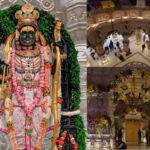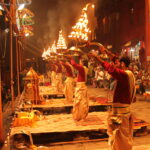“Varanasi… Banaras, Kashi” is derived from the river flowing in the city. As the city is situated between the Varuna River and Assi River, the name is derived from rivers and jointly called Varanasi… Banaras, Kashi.
Mark Twain once very famously remarked that Benaras is older than history, older than tradition, and even than legend and looks twice as old with all of them together. This is so very true for this quaintly charming land is indeed very old and takes pride in a History that dates back to 2500 years. The History of Varanasi begins with the settling of some Aryan tribes out here. They came from the north and made this land their home.
According to popular religious legend, Lord Shiva made Varanasi… Banaras, Kashi his home after marrying Parvati.
In the 1400’s however the Afghans completely routed the city and it had to be rebuilt. Actually, on account of its enviable location and prosperity Varanasi was the target of many rulers. The list of Muslim rulers to have invaded Varanasi includes Mahmud of Ghazni, Mahmud of Ghori, Sultan AllaudinKhilji and Mughal Emperor Aurangzeb.
As a result of these raids many temples and other ancient structures were destroyed. This is indeed very unfortunate but there is no denying that the History of this land flanked by the stretch of the sacred River Ganges continues to live.
We come to know that Varanasi was the prime center of the Bhakti movement. Spear headed by the likes of Ramananda and Kabir, this devotional movement took place in the 15th century. The latter was highly respected by Hindus and Muslims alike. Tulsidas credited with the translation of the Ramayana from Sanskrit to Hindi belonged to Varanasi.
Varanasi Ghats
Ghats in Varanasi are riverfront steps leading to the banks of the River Gangas. The city has 84 Ghats. Most of the Ghats are bathing and puja ceremony Ghats, while two are used exclusively as cremation sites.
Most Varanasi Ghats were rebuilt after 1700 AD when the city was part of the Maratha Empire. The patrons of current Ghats are Marathas, Shindes (Scindias), Holkars, Bhonsles, and Peshwes (Peshwas). Many Ghats are associated with legends or mythologies while many Ghats are privately owned.
Few Important Ghats of Varanasi starting From Assi Ghat:
- Assi Ghat
- Tulsi Ghat
- Panchkote Ghat
- Chet Singh Ghat & Fort
- Harish Chandra Ghat (Cremation Ghat)
- Kedar Ghat
- Chousatti Ghat
- Darbhanga Ghat
- Dashaswamedh Ghat
- Dr. Rajendra Prasad Ghat
- Manmandir Ghat
- Manikarnika Ghat (Creamition Ghat)
- Panchganga Ghat
- Rajghat
- Namo Ghat
Assi Ghat
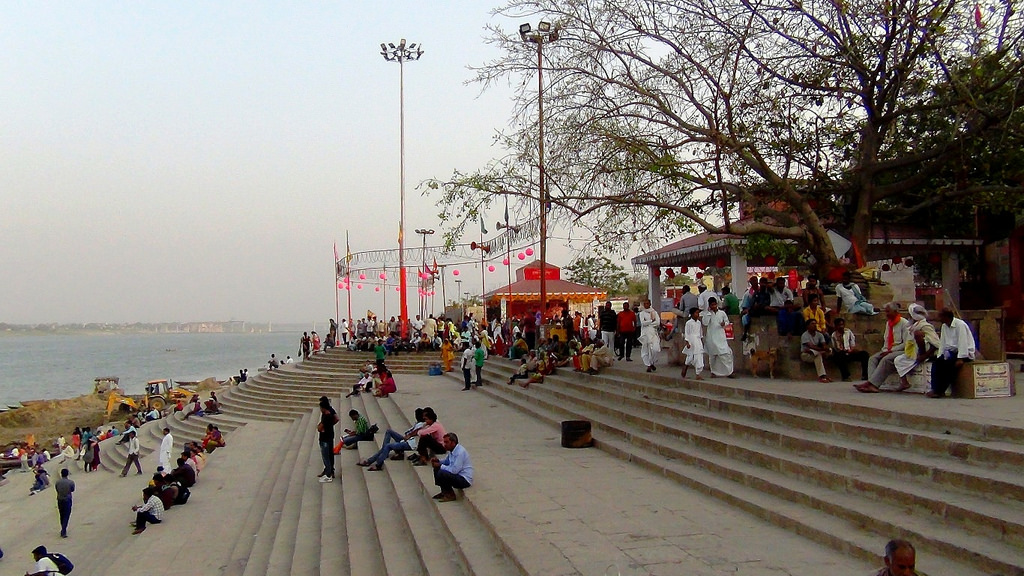
“Assi Ghat” is said to be the place where Assiriver meets the river Ganges. It is said in old text of Puranas that after slaying Shumbh-Nishumbh, goddess Durga has thrown her sword away, which has resulted in emeregence of big stream, i.e. Assiriver. It is also said that taking a dip at confluence of Assi and Ganges (i.e. AssiGhat) can results in punyas of 100s of such dips at other holy places.
“Assi Ghat” is the southernmost ghat in Varanasi. To most visitors to Varanasi, it is known for being a place where long-term foreign students, researchers, and tourists live. “Assi Ghat” is one of the ghats often visited for recreation and during festivals. On typical days about 300 people visit every hour in the mornings, and on festival days 2500 people arrive per hour. Most of the people visiting the ghat on usual days are students from the nearby Banaras Hindu University. The ghat accommodates about 22,500 people at once during festivals like Shivratri.
Tulsi Ghat
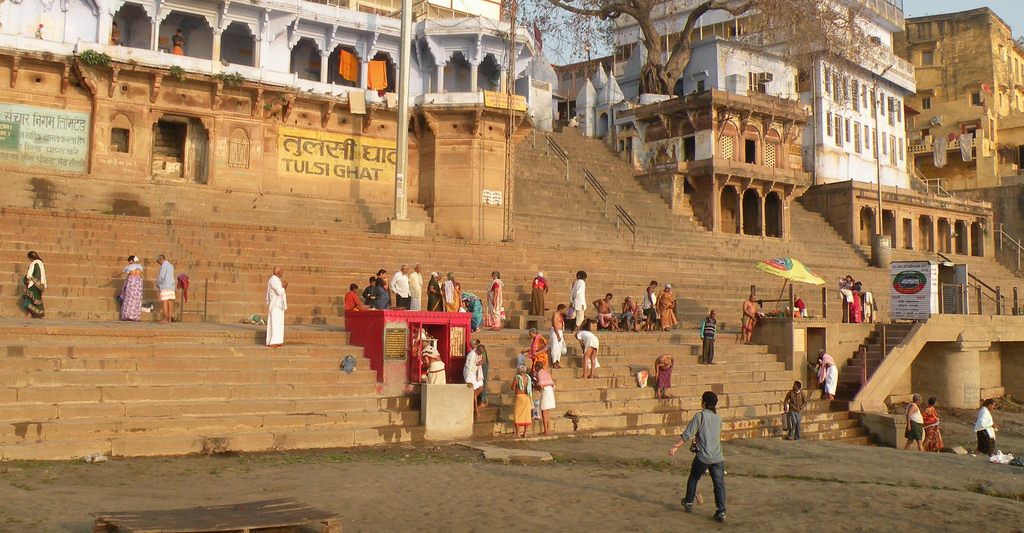
“Tulsi Ghat” is one of the ghats in Varanasi. It is named for Tulsidas who lived there while he wrote the Ramcharitmanas. Earlier, “Tulsi Ghat” was known as Lolark Ghat. It was in the year 1941 that “Tulsi Ghat” was made pucca (cemented) by the famous industrialist, Baldeo Das Birla.
Tulsi Ghat is the office base of the Sankat Mochan Foundation, a nongovernmental organization working to clean the river Ganga since 1982. Sankat Mochan Foundation is one of the biggest names associated with the Ganges cleaning project. Prof. Veer Bhadra Mishra, an environmentalist and social activist who is also the manager of Sankat Mochan Foundation, lives at Tulsi Ghat. Prof. Mishra was awarded the United Nations Environment Program’s Global 500 Roll of Honour in 1992.
Panchkote Ghat
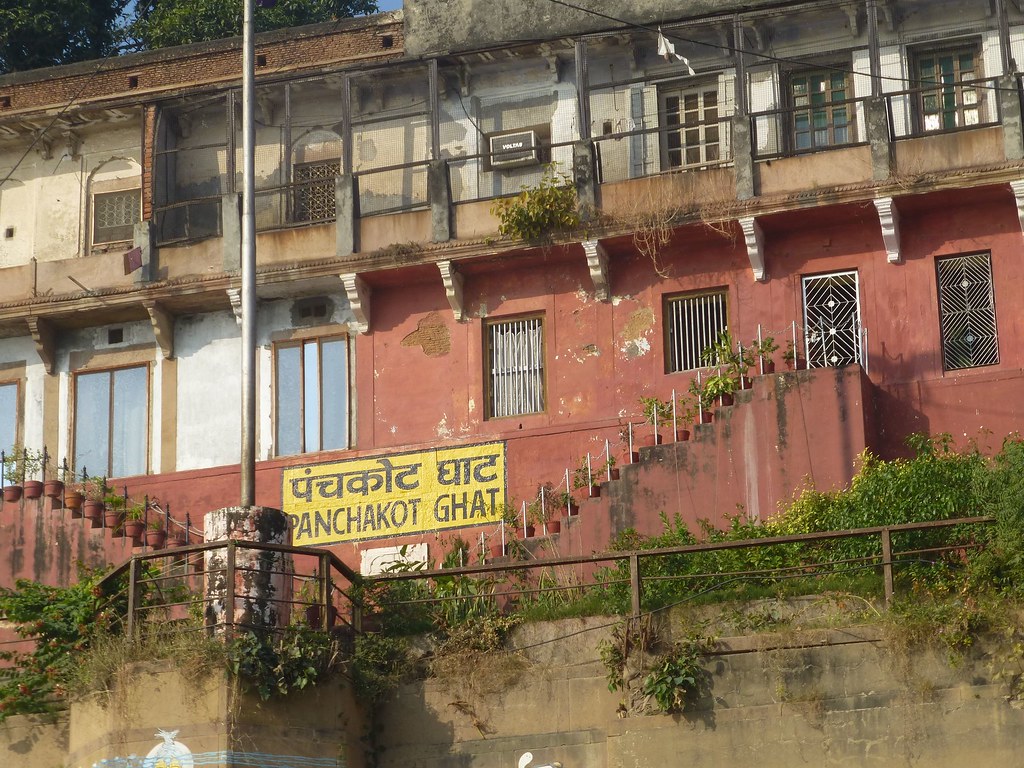
“Panchkota Ghat” is, though, of some historical relevance but, in relation to religious importance, it has lesser relevance. King of Panchkota (Bengal) constructed the ghat and a palatial building on the top of the “Panchkot Ghat” in the later half of 19th century. The ghat lies on the northern end of Prabhu Ghat of Varanasi. Adjacent to the palatial building are two temples as well.
Chetsingh Ghat & Fort
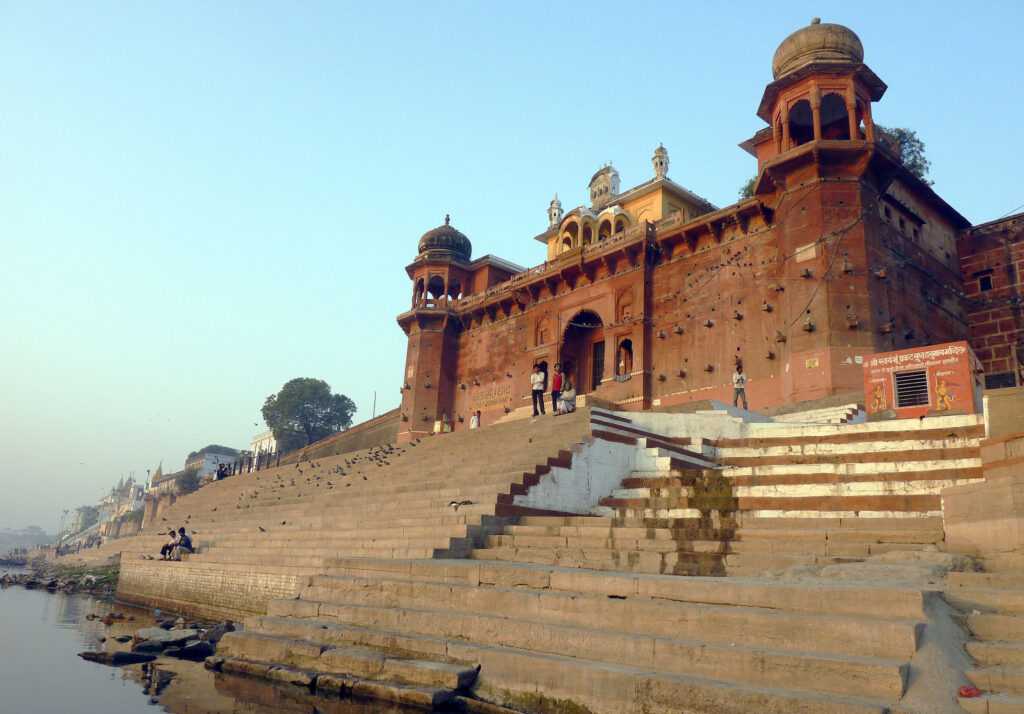
Chet Singh (1770-1781) built the palatial building of “Chet Singh Ghat & Fort” in mid the 18th century as a small fortress, which witnessed the fierce battle between the troops of Warren Hastings and Chet Singh in 1781 that resulted to the defeat of Chet Singh. Thus this fortress went under the control of British. In late 19th century the King Prabhunarayan Singh had again took the possession of this fort. The northern part of it was donated to Naga group of ascetics who late on built their monasteries and ghats, called Niranjani Ghat and Nirvani Ghat.
This palace has been his principal residence. This building composed of (a) a palace with pavilions, built on the terrace overlooking the Ganga, (b) a group of buildings for the women (demolished), and (c) a Mughal garden with darbar and water tower. The palace has a particularly favored relationship to the Ganga. It opens out onto the ghat which is a continuation of the palace and reached by means of monumental gateways. The gateway houses a stairway, which gives access to the terrace. There, a central pavilion stands looking out over the Ganga, on which the Maharaja appeared for glimpse. The terraced level is defined at two corners by two massive structures tapped by octagonal domed pavilions. There are three state temples of Shiva in the compound, built in 18th-19th century.
Harish Chandra Ghat

“Harish Chandra Ghat” is one of the oldest Ghats of Varanasi. “Harish Chandra Ghat” is name after a mythological King Harish Chandra, who once worked at the cremation ground here for the perseverance of truth and charity. It is believed that the Gods rewarded him for his resolve, charity and truthfulness and restored his lost throne and his dead son to him. Harish Chandra Ghat is one of the two cremation Ghats (the other being Manikarnika Ghat) and is sometimes referred as Adi Manikarnika (the original creation ground). Hindus from distant places bring the dead bodies of their near and dear ones to the Harish Chandra Ghat for cremation. In Hindu mythology it is believed that if a person is cremated at the Harish Chandra Ghat, that person gets salvation or “MOKSHA”. The Harish Chandra Ghat was somewhat modernized in late 1980’s, when an electric crematorium was opened here.
Kedar Ghat

The Kedar Ghat houses the Gauri Kund, a small water pool which has an image of Gauri, Lord Shiva’s wife in the eastern wall. It is said that the water in this kundhas healing properties. The Kedareswara Shiva Temple, at the “Kedar Ghat” has great mythological importance and it is believed that anyone who visits this temple gets blessings as the same after visiting Kedarnath Temple. According to mythology, the Kedar Ghat was the original site of Manikarnika Ghat and the Gauri Kunda on the ghat steps is referred to as “Adi Manikarnika.” These riverfront steps are referred to as greatest of the bathing tirthas in Kashi. Kedareshvara is one of the twelve Jyotirlingas in India. A puccaghat was constructed at this spot by the Government of Uttar Pradesh in 1958. It finds mention in the Puranas and is believed to be among the oldest ghats in Varanasi.
Chousatti Ghat
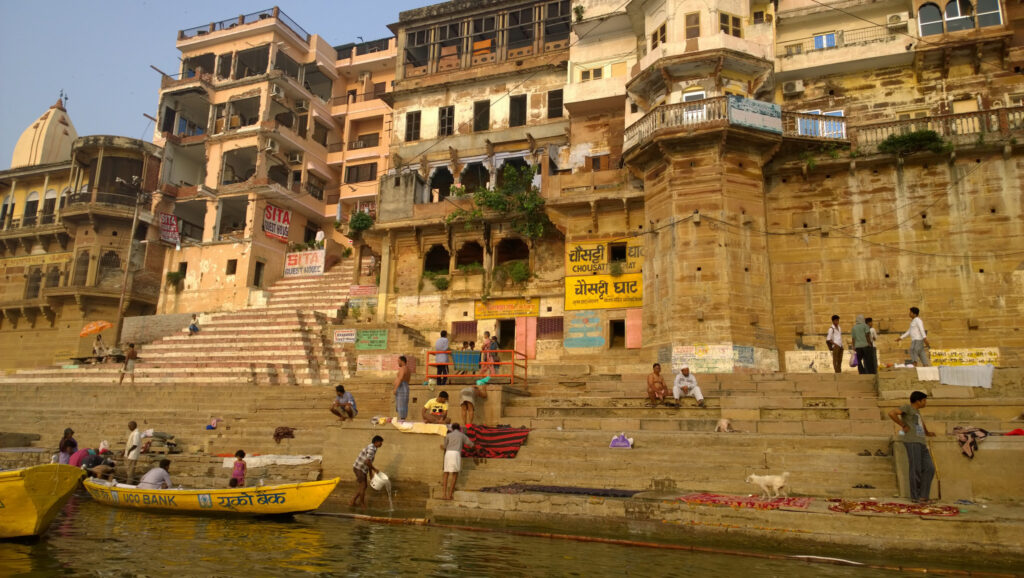
“Chousatti (Chausatthi) Ghat” is located south of Dasaswamedh Ghat next to Digpatiya Ghat. It is named after 64 (chausatha) goddesses. The steep steps lead to the Chausath Yogini Temple. A yogini is an assistant goddess and 60 of the 64 are enshrined in the temple. The temple is dedicated to the Goddess Kali, one of the most misunderstood Hindu goddesses, likely due to her wild and fearsome appearance. Kali has been called the goddess of death, destruction, and darkness. She is actually the mother goddess, with whom her devotees share a loving bond. Many Hindus come to the temple during the new moon day of the month of chaitra, an auspicious day when they take a dip in the Ganga. Non-Hindus are not permitted to enter the temple at any time.
Darbhanga Ghat
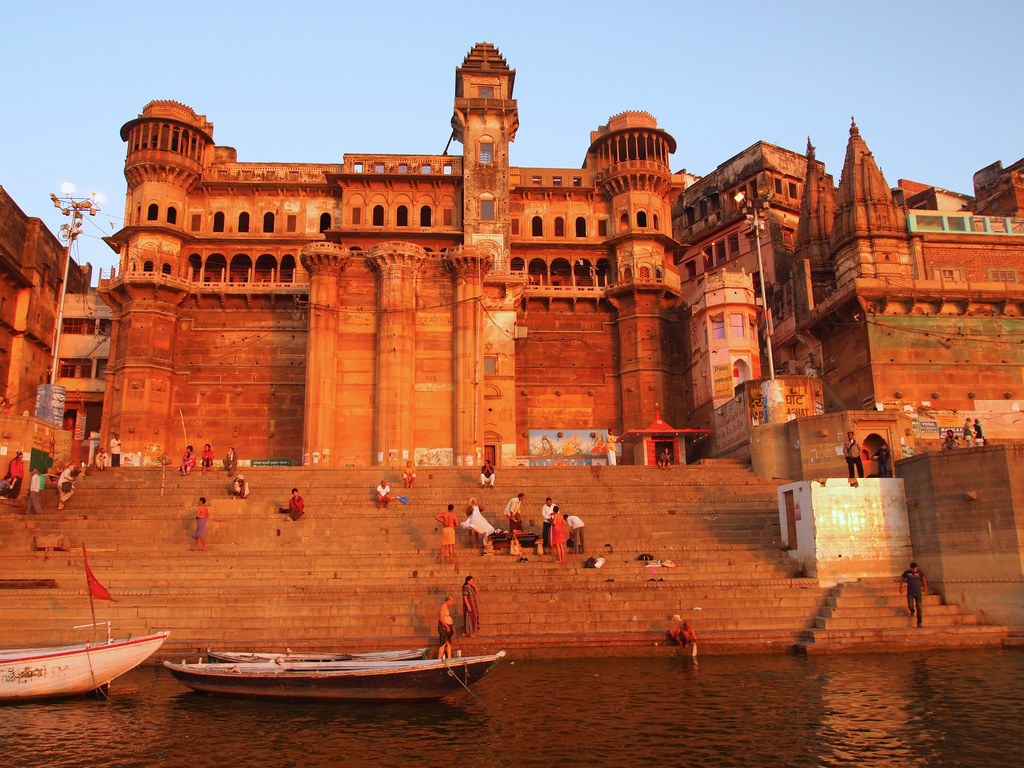
“Darbhanga Ghat” which is located south of Dasaswamedh Ghat next to Rana-Mahal Ghat. This imposing palace with its towers and turrets was built in the early 1900s by the royal family of Bihar. One of the highlights of this palace is the very early lift that was operated by hand, now said to be out of operation. Darbhanga Ghat has a temple dedicated to Lord Shiva. There is also a building nearby that is used for performing religious rituals.
Dashashwamedh Ghat
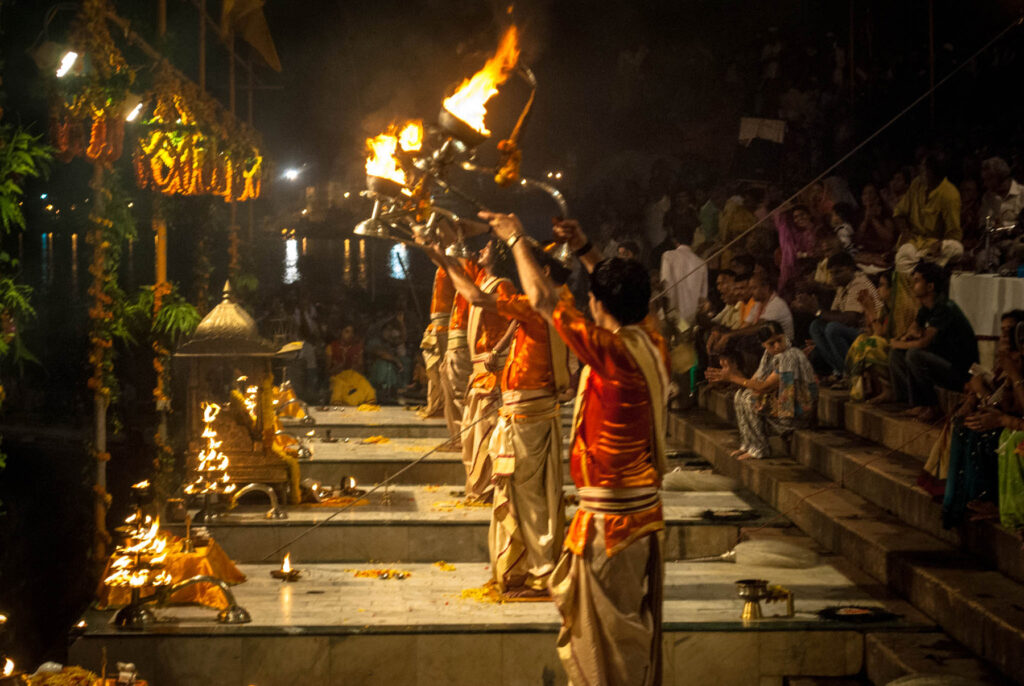
This is the busiest and the ancient most referred ghat. According to the myth related to Divodasa, Lord Brahma (” the creator” in the Hind trinity gods) performed the ten-horses sacrifice (dasa-asvamedha) at this site. The historical sources infer that at this site the revivalist Hindu dynasty of the second century, the Bhara Siva Nagas had performed ten-horses sacrifice. The records many verses describing glory of this ghat. These shrines are linked to several important pilgrimage journeys. The southern part of the ghat was made pucca in 1740 by Bajirao Pesava-1, and late in c.1774 by Ahilyabai Holkar of lndore.
Dashaswamedh Ghat is the main ghat in Varanasi Ganga River. It is near at Kashi Viswanath Temple .it’s most popular ghat in Varanasi. Two Hindu legends are associated with it: According to one, Lord Brahma created it to welcome Lord Shiva. According to another legend, Lord Brahma sacrificed ten horses during Dasa-Ashwamedhayagya performed here.
Special aartis are held on Tuesdays and on religious festivals and Ganga Aartis are held everyday here at Dashaswamedh Ghat.
Dr. Rajendra Prasad Ghat

In 1979 in memory and honour of the first president of India (1950-1962). Rajendra Prasad (1884-1963) this ghat was renamed, and made pucca by the Municipal Corporation of Varanasi. This ghat was the northern extension of Dasasvamedha Ghat. And until late nineteenth century, a stone statue of the horse was at the ghat witnessing the “ten-horses sacrifices” performed by Bhara Siva Nagas in second century, that is how the old name “Ghoda Ghat” (“Horse Ghat”). It is believed that same horse image is shifted to the Sankatmochana temple. The myth refers that servants of Bhara Siva Nagas taken bath here.
Man Mandir Ghat
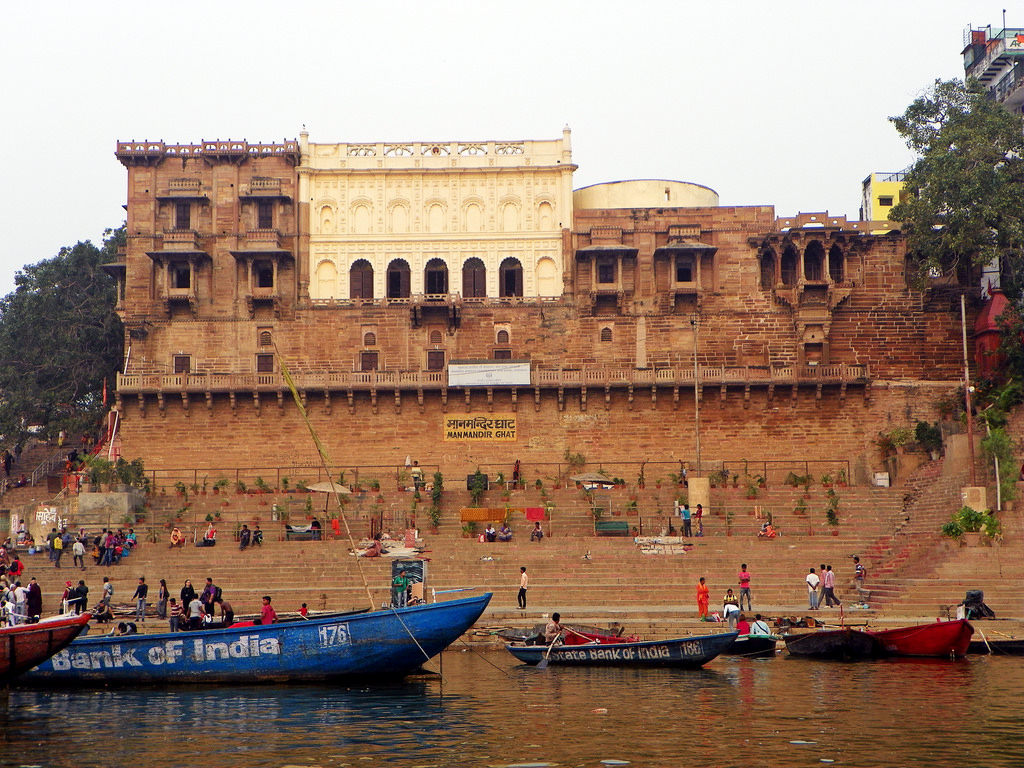
Man Mandir Ghat was built in 1600 by Maharaja Man Singh of Amer along with a palace known for the magnificent building with exquisite ornate window carvings and also for a very interesting observatory on the roof. The observatory at Man Mandir Ghat was built by Savai Jai Singh II in 1710. Observatory has huge instruments made from stone and was once used to study the movement of the sun, moon, star and other heavenly bodies. Jantar Mantar is the highlight of the observatory which is similar to Jantar Mantar located in Delhi, Jaipur, Ujjain and Mathura. There is a fine stone balcony in the northern part of the Ghat. Devotees pay homage here to the lingam of Someswar, the Lord of the Moon. Dom Raja’s house is next door, with painted tigers flanking the terrace. Doms, who handle the corpses at cremation grounds, are untouchables. Though the Doms belong to a lower caste, their services are invaluable for the dead to be released from their physical bounds and so the leader of the doms is bestowed with the honorific title of Raja or king.
Manikarnika Ghat (Burning Ghat)
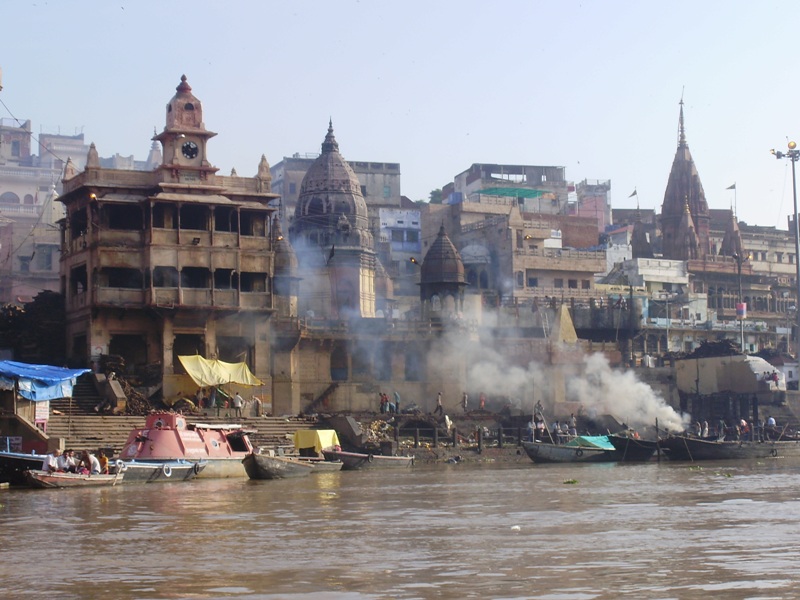
It is one of the oldest Ghats in Varanasi. The Manikarnika Ghat (Burning Ghat) is mentioned in a Gupta inscription of the 5th century. It is revered in the Hindu religion. When Mata Sati (Aadishaktimata) sacrificed her life & set her body ablaze after Raja Daksh Prajapati (one of the sons of Lord Brahma) tried to humiliate Lord Shiva in a Yagya practiced by Daksh. Lord Shiva took her burning body to the Himalayas. On seeing the unending sorrow of Lord Shiva, Vishnu sends the Divine chakra to cut the body into 51 parts which fall on earth. They are called “Ekannya Shaktipeeth”. Lord Shiva established Shakti Peeth wherever Sati’s body had fallen. At Manikarnika Ghat (Burning Ghat), Mata Sati’s Ear’s ornament had fallen. Hindu mythology teaches that the ghat is especially sacred and that people cremated there receive “MOKSHA”.
As the myth goes, Vishnu, after several thousand years of tapasya, trying to please Shiva, to convince him notto destroy the holy city of Kashi when he destroys the world, managed to do so. Lord Shiva along with Parvati came to Kashi before Vishnu to grant him his wish. Vishnu dug a kund (well) on the bank of Ganga for the bath of the couple. When Lord Shiva was bathing a Mani (Jewel) from his earring fell into the kund, hence the name Manikarnika (Mani: BeadsKarnam: EarAngad: Ornament).
There is another myth about the Ghats: the ear jewel from lord Shiva fell while he was dancing angrily, which fell on the earth and thus Manikarnika Ghat (Burning Ghat), formed.
Panchganga Ghat
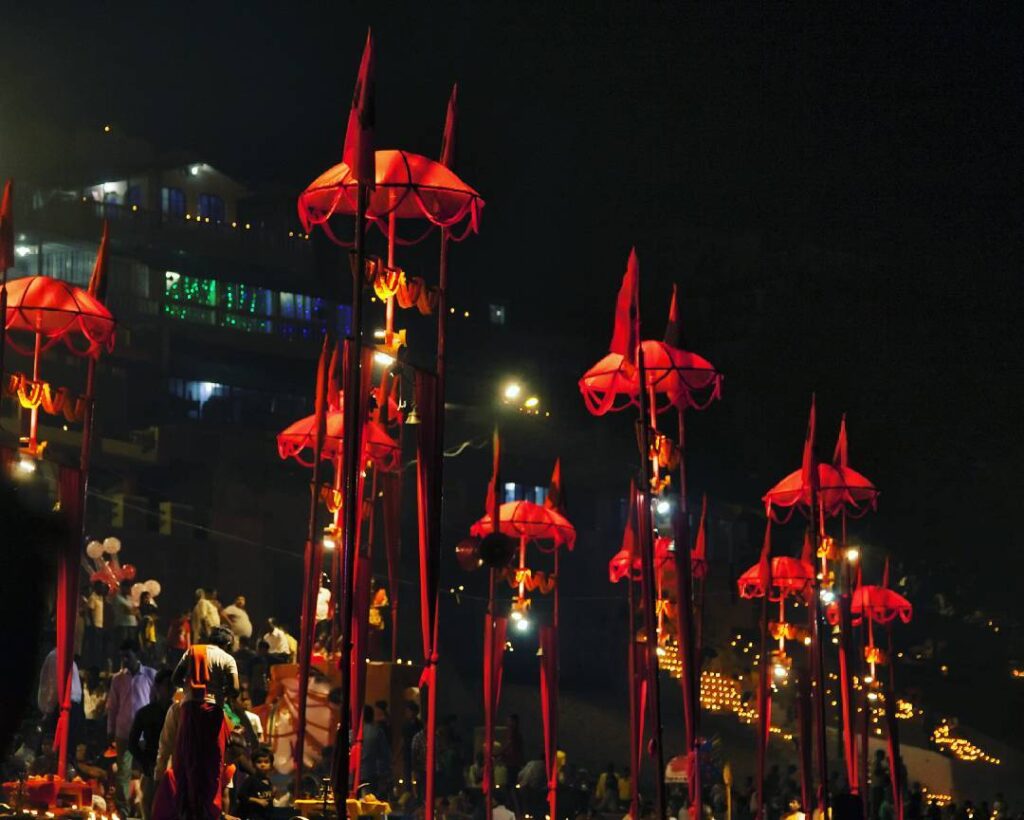
“Panchganga Ghat”, is the sacred ghat located at the confluence of five holy rivers (panchganga) namely, Ganga, Saraswati, Yamuna, Kirana, and Dhutapapa. Overlooking the ghat, there is a small Alamgir Mosque locally known as Beni Madhav-ka-Darera, built by Emperor Aurangzeb. The mosque was constructed on a place where there were ruins of a large Vishnu temple erected by the Maratha chieftain Beni Madhav Rao Scindia. Panchganga Ghat is credited with eight waterfront locations for doing religious rituals.
Rajghat

“Raj Ghat” is a Ghat of river Ganga located in Varanasi. This jetty was constructed by the Municipal Corporation. Raj Ghat is located in the back of the Malviya Setu (Dufferin Bridge) adjoining Kashi Railway Station. There is also a magnificent temple of Saint Ravidas. Varanasi (Kashi) has many beautiful ghats on the Ganges coast, all these ferries are related to some mythological or religious legend.
Namo Ghat
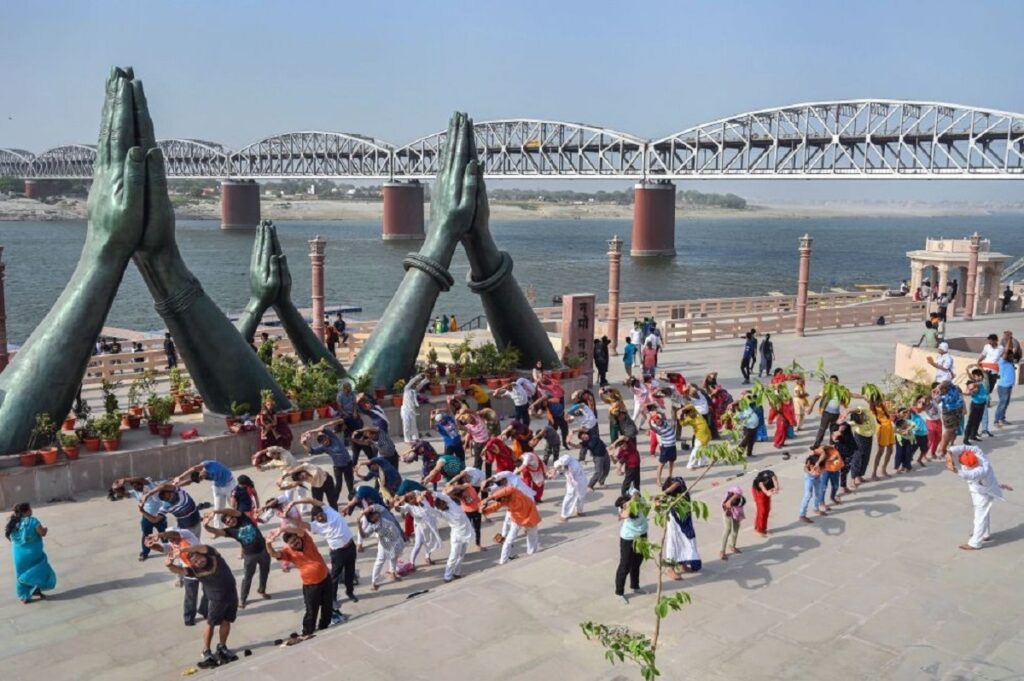
Namo Ghat, a tranquil haven away from the bustling crowds, emanates a serene ambiance that beckons those in search of solace and a profound connection with the divine. As the sun paints golden hues upon the tranquil waters during dawn and the evening lights create an ethereal spectacle, Namo Ghat stands as a testament to Varanasi’s mystical allure. In this blog, we embark on a journey to uncover the secrets held by Namo Ghat, where every stone and ripple tells a story of devotion and inner exploration. Join us as we step into the embrace of Namo Ghat, where spiritual currents seamlessly flow alongside the Ganges and ancient whispers of rituals echo through time. Delving into its calm, we unravel the layers of its significance, explore the rituals woven into the fabric of Varanasi’s heritage, and immerse ourselves in the tranquility that only the banks of the Ganges can provide.
